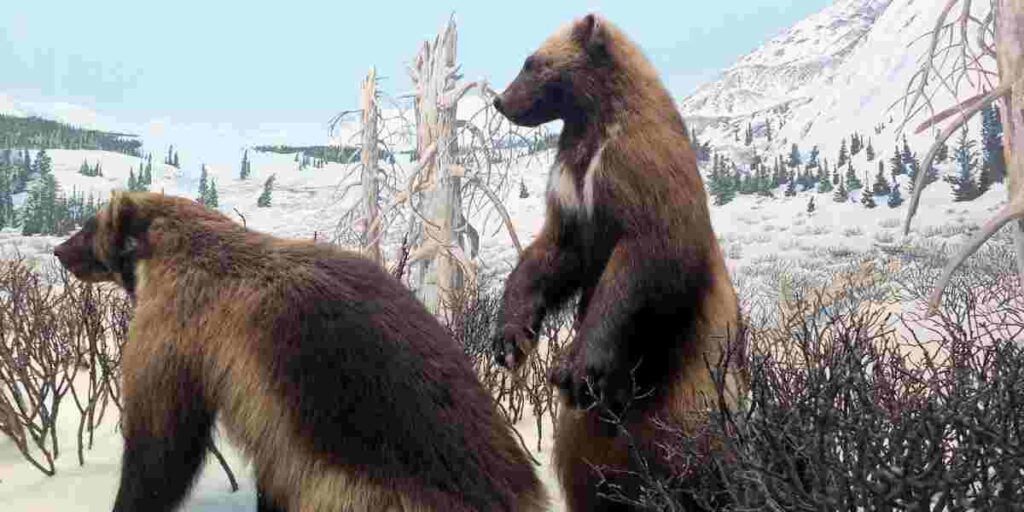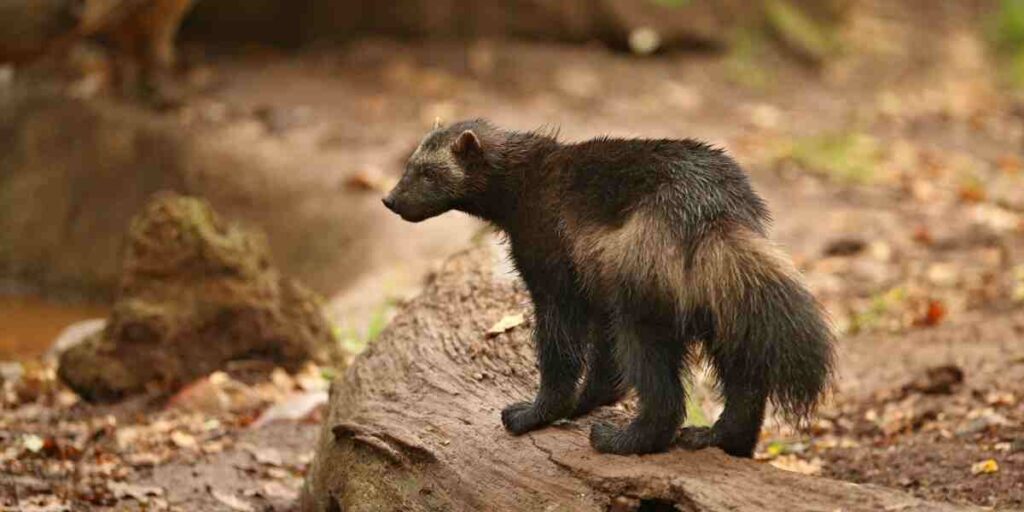Wolverines are much smaller than humans but are impressive in their own way. These animals, part of the mustelid family, which also includes weasels and otters, are known for their strength and agility. On average, a wolverine measures about 26 to 34 inches (66 to 86 cm) in length and weighs between 24 to 40 pounds (11 to 18 kg).
In contrast, the average human is around 5 feet 9 inches (175 cm) tall and weighs approximately 170 pounds (77 kg) for women and 198 pounds (90 kg) for men. This size difference is substantial, making wolverines much smaller than humans. Despite their smaller size, wolverines are known for their ability to survive in cold northern climates and timbered areas thanks to their strength and agility.
Average Length and Weight of Wolverines

Wolverines have a compact and sturdy build, which makes them look like miniature bears with short legs, short ears, and a bushy tail. They typically measure about 26 to 34 inches (66 to 86 cm) in length, from the tip of their nose to the end of their tail. Their weight ranges from 24 to 40 pounds (11 to 18 kg), with males generally being larger than females.
This size allows wolverines to be powerful and agile predators. Their muscular bodies and strong limbs, along with their sharp semi-retractile claws and sharp teeth, help them climb, dig, and hunt effectively, even in rough, timbered areas. Their size and adaptability help them survive in harsh conditions, including cold northern regions of North America and Eurasia
Sexual Dimorphism in Wolverines
Sexual dimorphism refers to the size differences between male and female wolverines. Male wolverines are typically larger and heavier than females. Males can weigh up to 40 pounds (18 kg), while females usually weigh around 24 pounds (11 kg). This size difference is due to genetic and environmental factors. Males tend to have a more robust build, which helps them compete for territory and resources.
This difference in size also affects the roles and behaviors of wolverines. Larger males often dominate fights and secure larger territories. Smaller female wolverines, being more agile, are better suited for caring for their young and moving quickly through dense timbered areas. Understanding these differences is crucial for studying wolverine behavior and conservation.
Comparison of Wolverine Size to Other Animals
Wolverines may be smaller compared to many other predators, but their size and strength make them unique in the animal kingdom. For example, wolverines are much smaller than bears. While wolverines typically weigh between 24 to 40 pounds (11 to 18 kg), bears can weigh anywhere from 200 to 1,500 pounds (90 to 680 kg), depending on the species. This size difference means that bears have the advantage in terms of strength and bulk, while wolverines rely on their agility and cunning to find food and protect themselves.
Wolverines are also smaller than wolves, which usually weigh between 40 to 175 pounds (18 to 79 kg). Despite this, wolverines are known for their fierce nature and determination. They often stand their ground against larger predators like bears and wolves to defend their food. Their smaller size also allows them to be highly adaptable, using their agility and speed to navigate rough terrain and outmaneuver other animals.
Wolverine Size Compared to Humans
The average height and weight of humans further illustrate how much smaller wolverines are in comparison. In the U.S., adult males are about 5 feet 9 inches (175 cm) tall and weigh around 198 pounds (90 kg). Adult females are typically 5 feet 4 inches (163 cm) tall and weigh about 171 pounds (77 kg). These averages show that humans are significantly larger and heavier than wolverines.
Wolverines usually measure between 26 to 34 inches (66 to 86 cm) long and weigh from 24 to 40 pounds (11 to 18 kg). This makes them much smaller in both length and weight compared to humans, who are several times larger. Despite their size, wolverines are known for their strength and agility, traits that are key to their survival in cold northern climates and timbered areas.
Visual Representation of the Size Difference
To clearly see the size difference between wolverines and humans, a visual comparison can be helpful. A side-by-side image or diagram showing a wolverine next to an average human can effectively illustrate how much smaller wolverines are. This visual aid makes it easier to understand the scale and highlights the contrast between their sizes.
Wolverine Size Compared to Other Animals
When comparing wolverines to other animals, especially predators, their size plays a significant role in how they behave and survive in the wild. Even though they are smaller than many other predators, wolverines have adapted in ways that help them thrive in tough environments.
- Comparison to Bears
Wolverines are much smaller than bears. While wolverines weigh between 20 to 55 pounds (9 to 25 kg), bears are much heavier, ranging from 200 to 1,500 pounds (90 to 680 kg) depending on the species. This size difference impacts how both animals hunt and find food. Bears have the advantage of brute strength and size, making them powerful hunters. Wolverines, on the other hand, rely on their agility and speed to catch prey or scavenge food. - Comparison to Wolves
Wolverines are also smaller compared to wolves. Wolverines weigh between 20 to 55 pounds (9 to 25 kg), while wolves typically weigh from 40 to 175 pounds (18 to 79 kg). Despite being smaller, wolverines are incredibly tough and often fearless. They are known to protect their food fiercely and will stand their ground even against larger predators like wolves. Their tenacity helps them survive in the wild despite their size disadvantage.
Impact on Behavior and Survival

Wolverines use their smaller size to their advantage by being more agile and able to move through rough terrain quickly. Their speed and agility help them catch prey and escape larger predators like bears and wolves. Wolverines can also scavenge food from larger predators, using their boldness and cunning to steal meals.
Their smaller size allows them to hide in tight spaces, offering protection from bigger animals. Wolverines’ toughness and tenacity enable them to defend their territory and food, ensuring their survival despite being smaller than many predators. Their ability to adapt to harsh environments plays a key role in their resilience and continued survival in the wild.
Geographic Variations in Wolverine Size

Wolverines display size differences depending on where they live. Wolverines found in cold northern regions, such as the Arctic tundra, tend to be larger. This is because a bigger body helps retain heat better, aiding survival in freezing temperatures.
In areas with plentiful food, wolverines may grow larger due to better nutrition. Conversely, in regions with less food or warmer climates, wolverines tend to be smaller, as the need for larger body mass is reduced. These regional variations show how wolverines adapt to their environment to survive and thrive.
Factors Influencing Wolverine Size Variations
Several factors contribute to the size differences seen among wolverines:
- Climate: Wolverines in colder climates are generally larger because a bigger body helps retain heat better, providing insulation against the cold. In contrast, wolverines in warmer regions are usually smaller, as less body mass is needed to manage heat.
- Food Availability: Regions with abundant food supply allow wolverines to grow larger due to better access to nutrition. In areas where food is scarce, wolverines may be smaller as a result of limited resources.
- Habitat: The type of environment, whether it’s dense forests or open tundra, impacts wolverine size. Larger wolverines are often found in areas where their size helps with survival, while smaller wolverines may thrive in habitats where agility and speed are more beneficial.
Frequently Asked Questions
How big do wolverines typically get?
Wolverines generally measure between 26 to 34 inches (66 to 86 cm) in length and weigh between 24 to 40 pounds (11 to 18 kg).
Are wolverines smaller than wolves?
Yes, wolverines are smaller than wolves, with wolverines typically weighing up to 55 pounds (25 kg) while wolves can weigh up to 175 pounds (79 kg).
Why are wolverines larger in colder climates?
Wolverines in colder climates tend to be larger because a bigger body helps them retain heat more effectively, which is crucial for survival in freezing conditions.
How do wolverines defend themselves against larger predators?
Wolverines use their agility, strength, and fierce nature to protect their territory and food. Their semi-retractile claws and sharp teeth allow them to defend themselves effectively against larger predators like bears and wolves.
What factors influence the size of wolverines?
The size of wolverines is influenced by a combination of factors, including climate, food availability, and habitat.
Conclusion
Wolverines, though smaller than many other predators and humans, have adapted remarkable survival strategies that make them stand out in the wild. As members of the mustelid family, their average size ranging from 26 to 34 inches in length and 24 to 40 pounds in weight belies their incredible strength and resilience.
The geographic and environmental factors that influence their size, from climate to food availability, only highlight the unique ways in which wolverines have evolved to thrive.
Also Read:

